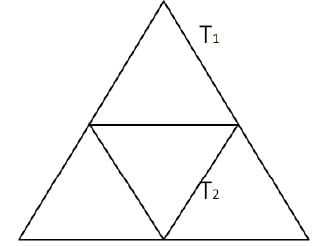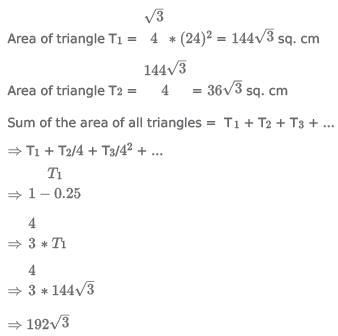CAT Exam > CAT Questions > Given an equilateral triangle T1 with side 24...
Start Learning for Free
Given an equilateral triangle T1 with side 24 cm, a second triangle T2 is formed by joining the midpoints of the sides of T1. Then a third triangle T3 is formed by joining the midpoints of the sides of T2. If this process of forming triangles is continued, the sum of the areas, in sq cm, of infinitely many such triangles T1, T2, T3,... will be
- a)188√3
- b)248√3
- c)164√3
- d)192√3
Correct answer is option 'D'. Can you explain this answer?
| FREE This question is part of | Download PDF Attempt this Test |
Verified Answer
Given an equilateral triangle T1 with side 24 cm, a second triangle T2...
We can see that T2 is formed by using the mid points of T1 . Hence, we can say that area of triangle of T2 will be (1/4)th of the area of triangle T1 .


Hence, option D is the correct answer.


Hence, option D is the correct answer.
Most Upvoted Answer
Given an equilateral triangle T1 with side 24 cm, a second triangle T2...
Let's label the vertices of the equilateral triangle T1 as A, B, and C.
First, let's find the side length of T2. Since T2 is formed by joining the midpoints of the sides of T1, the side length of T2 is half of the side length of T1. Therefore, the side length of T2 is 24/2 = 12 cm.
Next, let's find the side length of T3. Since T3 is formed by joining the midpoints of the sides of T2, the side length of T3 is half of the side length of T2. Therefore, the side length of T3 is 12/2 = 6 cm.
We can see that each subsequent triangle formed will have half the side length of the previous triangle. This means that the side length of T4 will be 6/2 = 3 cm, the side length of T5 will be 3/2 = 1.5 cm, and so on.
The sum of the areas of infinitely many triangles T1, T2, T3,... can be found using the formula for the sum of an infinite geometric series:
Sum = a / (1 - r)
where a is the first term and r is the common ratio.
In this case, a = area of T1 = (sqrt(3) / 4) * (24)^2 = 72sqrt(3) cm^2
and r = 1/2 (since each subsequent triangle has half the side length of the previous triangle).
Therefore, the sum of the areas of infinitely many triangles T1, T2, T3,... is:
Sum = (72sqrt(3)) / (1 - 1/2) = (72sqrt(3)) / (1/2) = 144sqrt(3) cm^2
Since 144sqrt(3) is approximately 249.13 cm^2, the answer is not 188 cm^2.
Therefore, the correct answer is not listed.
First, let's find the side length of T2. Since T2 is formed by joining the midpoints of the sides of T1, the side length of T2 is half of the side length of T1. Therefore, the side length of T2 is 24/2 = 12 cm.
Next, let's find the side length of T3. Since T3 is formed by joining the midpoints of the sides of T2, the side length of T3 is half of the side length of T2. Therefore, the side length of T3 is 12/2 = 6 cm.
We can see that each subsequent triangle formed will have half the side length of the previous triangle. This means that the side length of T4 will be 6/2 = 3 cm, the side length of T5 will be 3/2 = 1.5 cm, and so on.
The sum of the areas of infinitely many triangles T1, T2, T3,... can be found using the formula for the sum of an infinite geometric series:
Sum = a / (1 - r)
where a is the first term and r is the common ratio.
In this case, a = area of T1 = (sqrt(3) / 4) * (24)^2 = 72sqrt(3) cm^2
and r = 1/2 (since each subsequent triangle has half the side length of the previous triangle).
Therefore, the sum of the areas of infinitely many triangles T1, T2, T3,... is:
Sum = (72sqrt(3)) / (1 - 1/2) = (72sqrt(3)) / (1/2) = 144sqrt(3) cm^2
Since 144sqrt(3) is approximately 249.13 cm^2, the answer is not 188 cm^2.
Therefore, the correct answer is not listed.
Attention CAT Students!
To make sure you are not studying endlessly, EduRev has designed CAT study material, with Structured Courses, Videos, & Test Series. Plus get personalized analysis, doubt solving and improvement plans to achieve a great score in CAT.

|
Explore Courses for CAT exam
|

|
Similar CAT Doubts
Given an equilateral triangle T1 with side 24 cm, a second triangle T2 is formed by joining the midpoints of the sides of T1. Then a third triangle T3 is formed by joining the midpoints of the sides of T2. If this process of forming triangles is continued, the sum of the areas, in sq cm, of infinitely many such triangles T1, T2, T3,... will bea)188√3b)248√3c)164√3d)192√3Correct answer is option 'D'. Can you explain this answer?
Question Description
Given an equilateral triangle T1 with side 24 cm, a second triangle T2 is formed by joining the midpoints of the sides of T1. Then a third triangle T3 is formed by joining the midpoints of the sides of T2. If this process of forming triangles is continued, the sum of the areas, in sq cm, of infinitely many such triangles T1, T2, T3,... will bea)188√3b)248√3c)164√3d)192√3Correct answer is option 'D'. Can you explain this answer? for CAT 2024 is part of CAT preparation. The Question and answers have been prepared according to the CAT exam syllabus. Information about Given an equilateral triangle T1 with side 24 cm, a second triangle T2 is formed by joining the midpoints of the sides of T1. Then a third triangle T3 is formed by joining the midpoints of the sides of T2. If this process of forming triangles is continued, the sum of the areas, in sq cm, of infinitely many such triangles T1, T2, T3,... will bea)188√3b)248√3c)164√3d)192√3Correct answer is option 'D'. Can you explain this answer? covers all topics & solutions for CAT 2024 Exam. Find important definitions, questions, meanings, examples, exercises and tests below for Given an equilateral triangle T1 with side 24 cm, a second triangle T2 is formed by joining the midpoints of the sides of T1. Then a third triangle T3 is formed by joining the midpoints of the sides of T2. If this process of forming triangles is continued, the sum of the areas, in sq cm, of infinitely many such triangles T1, T2, T3,... will bea)188√3b)248√3c)164√3d)192√3Correct answer is option 'D'. Can you explain this answer?.
Given an equilateral triangle T1 with side 24 cm, a second triangle T2 is formed by joining the midpoints of the sides of T1. Then a third triangle T3 is formed by joining the midpoints of the sides of T2. If this process of forming triangles is continued, the sum of the areas, in sq cm, of infinitely many such triangles T1, T2, T3,... will bea)188√3b)248√3c)164√3d)192√3Correct answer is option 'D'. Can you explain this answer? for CAT 2024 is part of CAT preparation. The Question and answers have been prepared according to the CAT exam syllabus. Information about Given an equilateral triangle T1 with side 24 cm, a second triangle T2 is formed by joining the midpoints of the sides of T1. Then a third triangle T3 is formed by joining the midpoints of the sides of T2. If this process of forming triangles is continued, the sum of the areas, in sq cm, of infinitely many such triangles T1, T2, T3,... will bea)188√3b)248√3c)164√3d)192√3Correct answer is option 'D'. Can you explain this answer? covers all topics & solutions for CAT 2024 Exam. Find important definitions, questions, meanings, examples, exercises and tests below for Given an equilateral triangle T1 with side 24 cm, a second triangle T2 is formed by joining the midpoints of the sides of T1. Then a third triangle T3 is formed by joining the midpoints of the sides of T2. If this process of forming triangles is continued, the sum of the areas, in sq cm, of infinitely many such triangles T1, T2, T3,... will bea)188√3b)248√3c)164√3d)192√3Correct answer is option 'D'. Can you explain this answer?.
Solutions for Given an equilateral triangle T1 with side 24 cm, a second triangle T2 is formed by joining the midpoints of the sides of T1. Then a third triangle T3 is formed by joining the midpoints of the sides of T2. If this process of forming triangles is continued, the sum of the areas, in sq cm, of infinitely many such triangles T1, T2, T3,... will bea)188√3b)248√3c)164√3d)192√3Correct answer is option 'D'. Can you explain this answer? in English & in Hindi are available as part of our courses for CAT.
Download more important topics, notes, lectures and mock test series for CAT Exam by signing up for free.
Here you can find the meaning of Given an equilateral triangle T1 with side 24 cm, a second triangle T2 is formed by joining the midpoints of the sides of T1. Then a third triangle T3 is formed by joining the midpoints of the sides of T2. If this process of forming triangles is continued, the sum of the areas, in sq cm, of infinitely many such triangles T1, T2, T3,... will bea)188√3b)248√3c)164√3d)192√3Correct answer is option 'D'. Can you explain this answer? defined & explained in the simplest way possible. Besides giving the explanation of
Given an equilateral triangle T1 with side 24 cm, a second triangle T2 is formed by joining the midpoints of the sides of T1. Then a third triangle T3 is formed by joining the midpoints of the sides of T2. If this process of forming triangles is continued, the sum of the areas, in sq cm, of infinitely many such triangles T1, T2, T3,... will bea)188√3b)248√3c)164√3d)192√3Correct answer is option 'D'. Can you explain this answer?, a detailed solution for Given an equilateral triangle T1 with side 24 cm, a second triangle T2 is formed by joining the midpoints of the sides of T1. Then a third triangle T3 is formed by joining the midpoints of the sides of T2. If this process of forming triangles is continued, the sum of the areas, in sq cm, of infinitely many such triangles T1, T2, T3,... will bea)188√3b)248√3c)164√3d)192√3Correct answer is option 'D'. Can you explain this answer? has been provided alongside types of Given an equilateral triangle T1 with side 24 cm, a second triangle T2 is formed by joining the midpoints of the sides of T1. Then a third triangle T3 is formed by joining the midpoints of the sides of T2. If this process of forming triangles is continued, the sum of the areas, in sq cm, of infinitely many such triangles T1, T2, T3,... will bea)188√3b)248√3c)164√3d)192√3Correct answer is option 'D'. Can you explain this answer? theory, EduRev gives you an
ample number of questions to practice Given an equilateral triangle T1 with side 24 cm, a second triangle T2 is formed by joining the midpoints of the sides of T1. Then a third triangle T3 is formed by joining the midpoints of the sides of T2. If this process of forming triangles is continued, the sum of the areas, in sq cm, of infinitely many such triangles T1, T2, T3,... will bea)188√3b)248√3c)164√3d)192√3Correct answer is option 'D'. Can you explain this answer? tests, examples and also practice CAT tests.

|
Explore Courses for CAT exam
|

|
Suggested Free Tests
Signup for Free!
Signup to see your scores go up within 7 days! Learn & Practice with 1000+ FREE Notes, Videos & Tests.
























